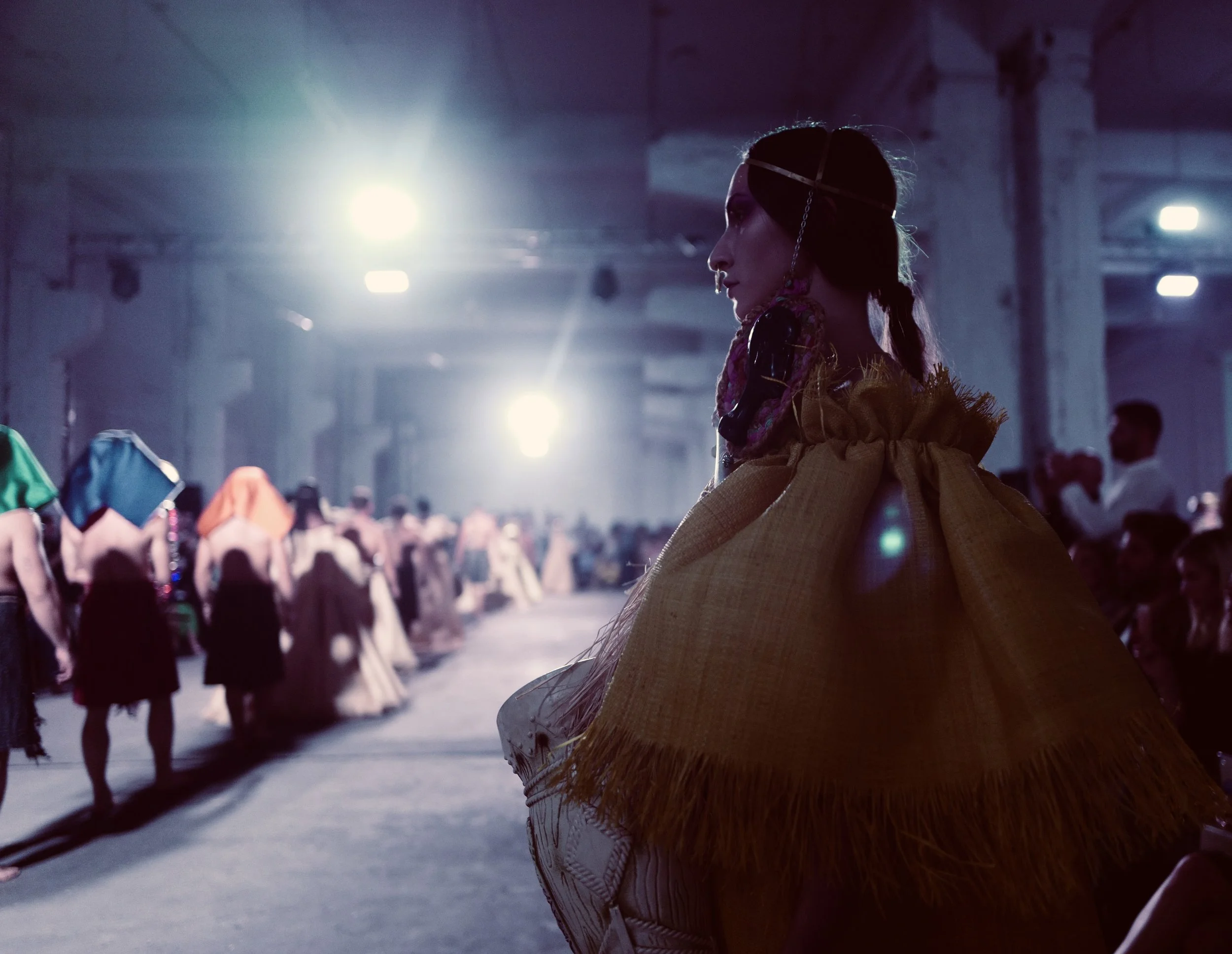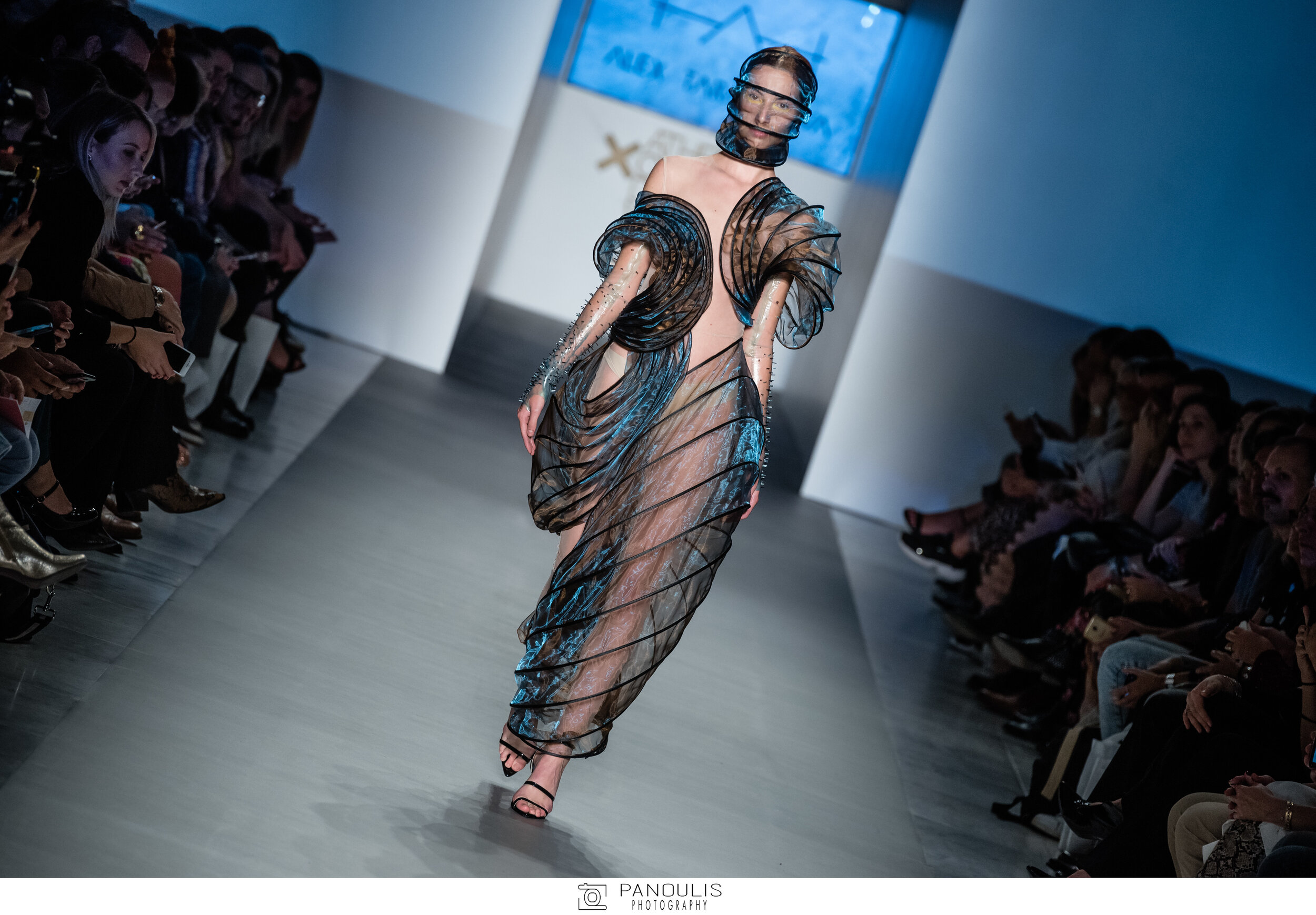by Omi & Cara Livingstone
Athens Xclusive Designer Week at its 26th iteration threw a few curve balls while remaining the primary gauge of where the industry is moving within the Greek fashion scene.
The shows that stood out this cycle had very little in common in terms of aesthetics but in terms of foundational philosophy shared a sense of adventure and exploration into the unknown.
The most interesting and probably the most talked-about show during AXDW was Vassilis Zoulias feat. Pericles Kondylatos. If that was a mouthful, the show itself was an eyeful. Structured on the back of "Novus Ordo Seclorum" (New Order of the Ages) which is one of the two mottos of the great seal of the United States of America, the whole show was an exploration of the evolving order of civilizations from the Incas to the Egyptians to the Greeks. Infusing the obvious absurdity of Orientalism within the constructs of a narrative that is not only exceptionally ambitious and broad but also hard to pull off with any budget, Kondylatos's somehow was able to hold up each thread of historical aesthetics with a sense of whimsy and clarity. That in itself is a mighty mighty task. Add Zoulias's venture into the eco-friendly fabric universe and it is a show that divided the greek fashion public instantly as they expected silk and satin, unicorns and rainbows not a strong shield-maiden sporting the heads of her fallen adversaries.
Zoulias is known for his silhouettes and ultra-feminine aesthetics, so to find that same silhouette in the fabric that is raw to your senses is a shock to the system by itself for many who have followed his work. In many ways, this specific moment of Kondylatos's genius and Zoulias's excellence converging as a sour note to local expectation is like the moment Bob Dylan went electric in New Port in 1965. This moment just like that moment shattered the preconceived notion of what artists can do vs should do. There were visibly shocked audiences within the show and afterward one of the greek editors shook her head and suggested this was just a grand joke. Joke or not, this was a show that took a day to process and as someone who has watched more than 150 shows in the last three months in four different continents, that is quite a feat. And that in itself is a testament to the fluidity, friction and the levity of art in its most complicated form. Kondylatos's take on the civilizational progression through aesthetics complemented by Zoulias's form factors was visually stunning and theatre aside each piece of fashion aesthetic was well thought out. The grim subversive tone to the harsh visuals of an evolving age that is just a stepping stone for what's to come was a rather audacious shot in a foggy catwalk which felt just right even after the moment passed. This was the first show where Zoulias's work took a more subtle role while elevating Kondylatos's work to the focal point (not that it needed that much elevation in the first place). Love it or hate it, there was no escape from the proficiency and theatrics of the show itself and when the dust of several civilizations along with the confused faces of the audiences have settled into introspection, Zoulias featuring Kondylatos became the most interesting and probably the most authentic dissection of aesthetic production of the season. Whether that is pleasing to the greek public is a matter of debate but ultimately the utility of art is not decoration but contemplation.
If Zoulias and Kondylatos were going for the jugular, then surely Yvonne Bosnjak was a bit of monotone goodness like Mexican chocolate that has a sweet taste but a spicy aftertaste. Bosnjak is not very well known outside the regional markets but her work has been progressing quite rapidly since 2016 and in this collection, she seemed to find her go-to silhouettes that is most consistent with her sense of visual symmetry. Keeping the foundational color palette to more or less binary, she did a deep dive into what makes the human form so intoxicating and alluring and came up with a full collection that speaks to a whole host of women across various social, cultural and economic groups. An element of inclusivity sprinkled across the notion of exclusivity became the foundation of her show.
The element of her work that stood out the most was the overwhelming projection of feminist exploration of masculine attributes. Clothes are never strong or weak, it is the person who wears them that dictate that dynamic, that being said, Bosnjak's work provides the platform for exploring the empowered notion of femininity. Whether or not that constructs a new form of feminism that is comfortable with masculinity in its dualist form (non-toxic and toxic) is a conversation for a more serious article, but as a fashion show, it was visually exciting and true to its purpose. On top of that, the binary color combination with just the right kind of sheen and glamor made it one of the most polished show of the AXDW.
Bosnjak's ability to construct an ensemble and stick to a singular narrative suggests a designer who is able to focus on one idea and build a full collection on it. And that is rare especially within smaller markets like Greece where designers tend to create mini collections within collections out of commercial necessity or inexperience. Bosnjak's aesthetic philosophy is still evolving to an extent but her finishing is exquisite bordering on world class. And if there is consistent progression within the understanding and dissection of form and function, she has the all the capacity and talent to become a significant force within the international market.
Already a force within the Italian circuit Afroditi Hera is one of the most consistent and visually interesting designers to come out of the greek isles in the last 20 years. Her handwoven silk kaftan may seem traditional to the naked eye but the innovation that comes with it (in the form of invisible hooks) goes beyond the realm of any traditionalism.
Afroditi's collection with tribal prints concocting geometric shapes through the prism of her kaftans was surely one of the highlights of AXDW. The innovative aspect of the clothes along with her mature, self-assured exploration of color made her show stand out. Her ability to formulate visual storytelling in each piece is unique even within the international market let alone the Greek market. Afroditi is able to create pieces that are formulaic and unique at the same time which in itself sounds, feels and looks counter-intuitive yet there is no struggle or clash of symmetry there. It is seamless yet it deconstructs, it is full of movement yet the structure of the silhouettes remains true. There is a beautiful equipoise to her work that comes from years of perfecting what she does and that hours and hours spent in the atelier shines through even in the most common of second of the runway. Afroditi's work is entrenched within the color theory Goethe prescribed where color is not treated as an analytical phenomenon but a prescriptive phenomenon. She uses color and patterns with a sense of purpose and vigor that feels like a strong gust of wind on a hot summer day or a wild boar running through a garden of tulips... and there lies the variability and the beauty of her work. Accomplished, assured, euphoric and ultimately wonderfully crafted pieces made this collection a crowd favorite.
Moving away from established designer into the new breed of Greek visual artists, we must mention the work of Paris Laliotis. Laliotis is a fairly new name within the Greek fashion industry and he embraces his relative obscurity with the vigor of a young creative. His collection titled "Labyrinth" incorporated Cretan mythology into constructs of wearable fashion and avant-garde headpieces. The clothes themselves had an element of glamor and deconstruction while holding on to their intended silhouettes. Minotaur and his fight with Theseus in the dark maze was the mythology that was the primary visual marker for the show. And anyone familiar with Cretan mythology knows that it is fraught with tragedy and gloom wrapped in a sense of glory and euphoria. Laliotis seems to be able to tap into both extremes to produce a collection that is rich in historical narrative and functional enough to be worn by the avant-garde crowd. His headpieces were beautifully crafted and added a layer of subversive whimsy and a bit of dark comedy to the process. Transitioning between the functional and the outright art-pieces Laliotis is likely to carve out a niche of its own within the fashion-art community. And if his work is any indication of what is to come, then we all ought to be very excited.
If Laliotis was on the cusp of avant-garde then Alex Taratynova went all-in into the fold. Her capsule collection inspired by fluid dynamics provided a sudden rush of excitement (no pun intended) to a relatively uneventful day.
The comparison between Iris van Herpen and Taratynova's capsule collection is inevitable because of the structural element and how fluid dynamics is envisioned through the movement of waves. Ethereal and translucent fabric construction posited into purple and blue palettes made the capsule worth a double-take. The breathable masks with fish scale-like construction complemented the overall aesthetics of the show and provided a glimpse of Taratynova's talent.
AXDW is now a proper last stop for many editors and as the industry evolves and moves forward it is likely that it will become a staple for regional fashion that is exportable easily. And with the cultural winds of change coming from the east with disposable income, easier access to the greek capital, it is likely that the greek fashion market might see an expansion in China and South Asia if the aesthetics and the quality remains the same. These might be early days but Greek fashion is on the rise.
















